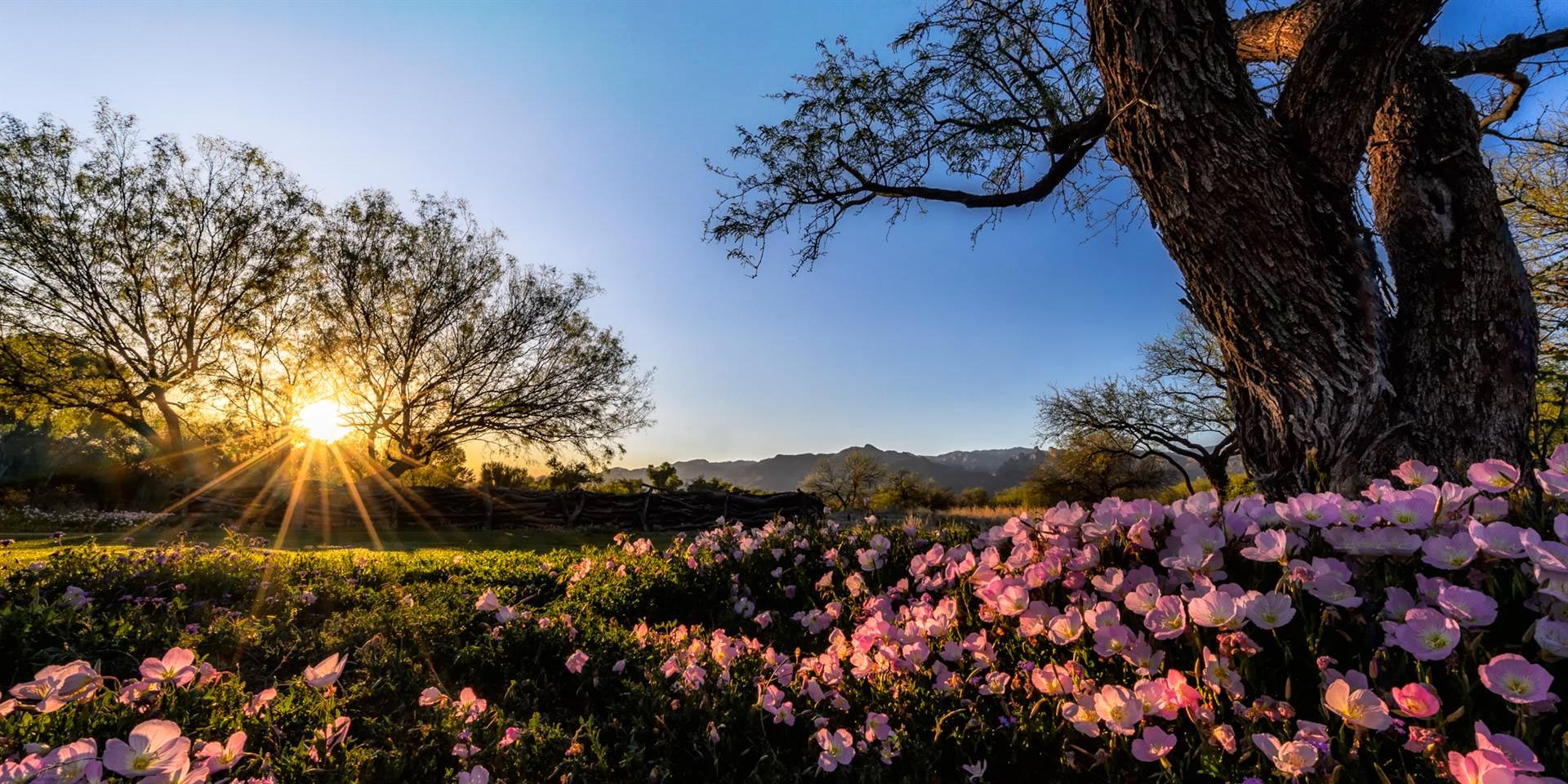Brochures and Other Printed Native Plant Information
| What You’ll See | Article Title with Link | Brief Description |
 | Brochure on Desert Bird Gardening | The plants described in this booklet were chosen because of their usefulness in attracting birds and because they are adapted to conditions in the deserts of the Southwest… |
 | Brochure on Arizona Native Grasses | The Arizona Native Plant Society published this booklet to promote the understanding and use of grasses native to, or naturalized in the Southwest. Native grasses have an important role in the restoration and reclamation of our native plant communities as well as in urban and rural landscapes. |
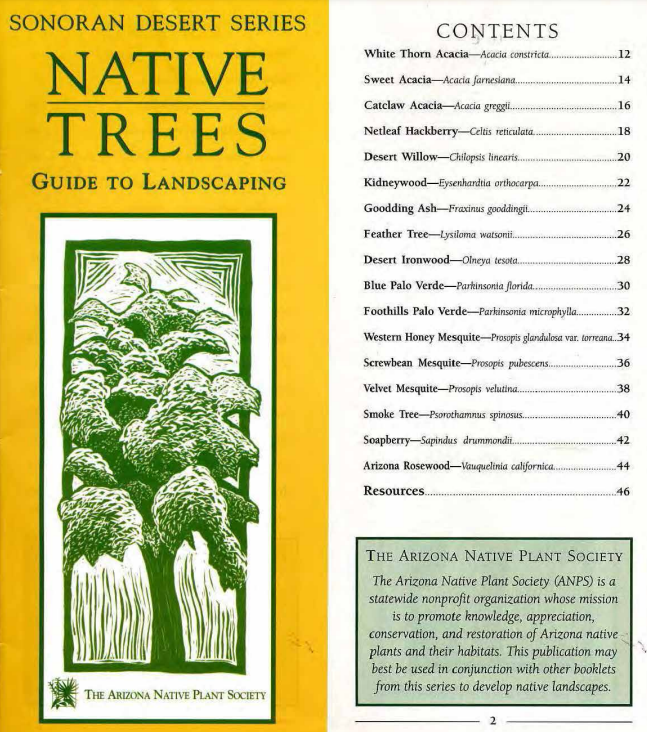 | Brochure on Arizona Native Trees | Creating a landscape in the desert should be a rewarding experience. A beautiful, native yard will bring endless enjoyment, attract butterflies, native pollinators and birds and give you more time to enjoy it than planting with non-natives. |
 | Brochure on Desert Wildflowers | Eighty-six species of wildflowers are described in this booklet. The vast majority are native to the Sonoran Desert, plus a few exotic wildflowers that are low water users. |
 | Brochure on Native Plants for Tortoises | Native plants of the Sonoran Desert are perfectly adapted to our climate and offer superior nutrition for the captive desert tortoise. |
Invasive Plant Information
| What You’ll See | Article Title with Link | Brief Description |
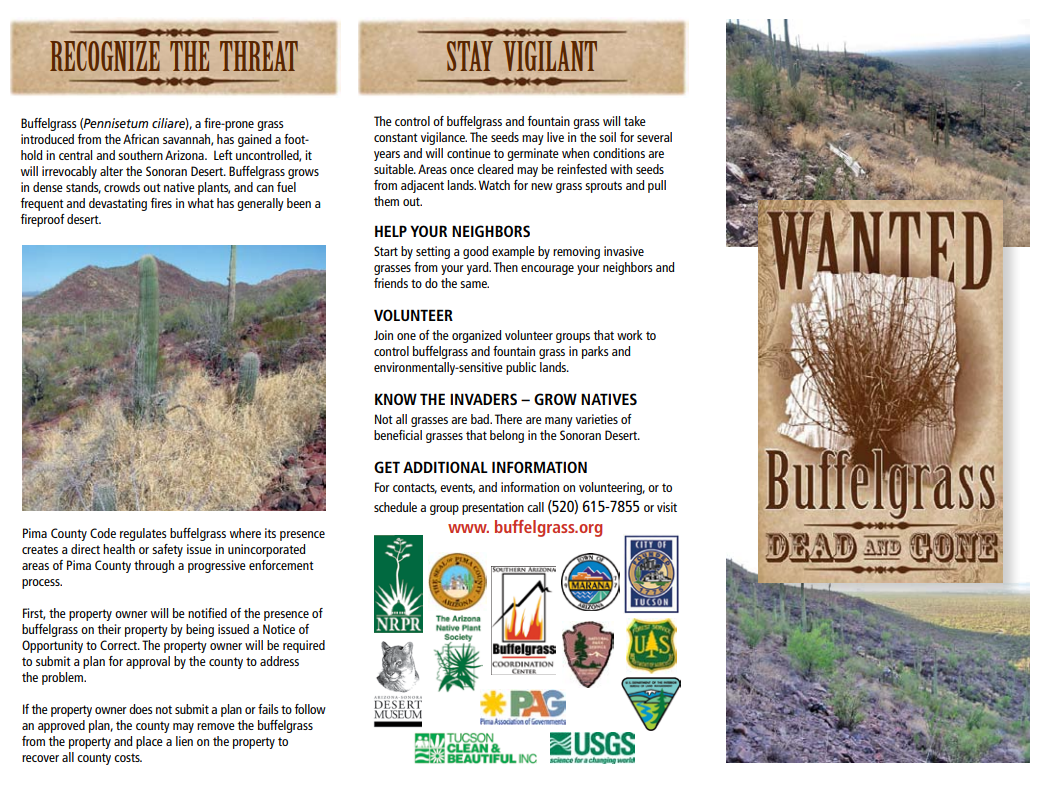
| Wanted: Buffelgrass, Dead and Gone (English) | Buffelgrass spreads aggressively by seed that forms dense stands and crowds out native plants. The dense growth supports hot fires that kill saguaros and other signature plants of the Sonoran Desert. |
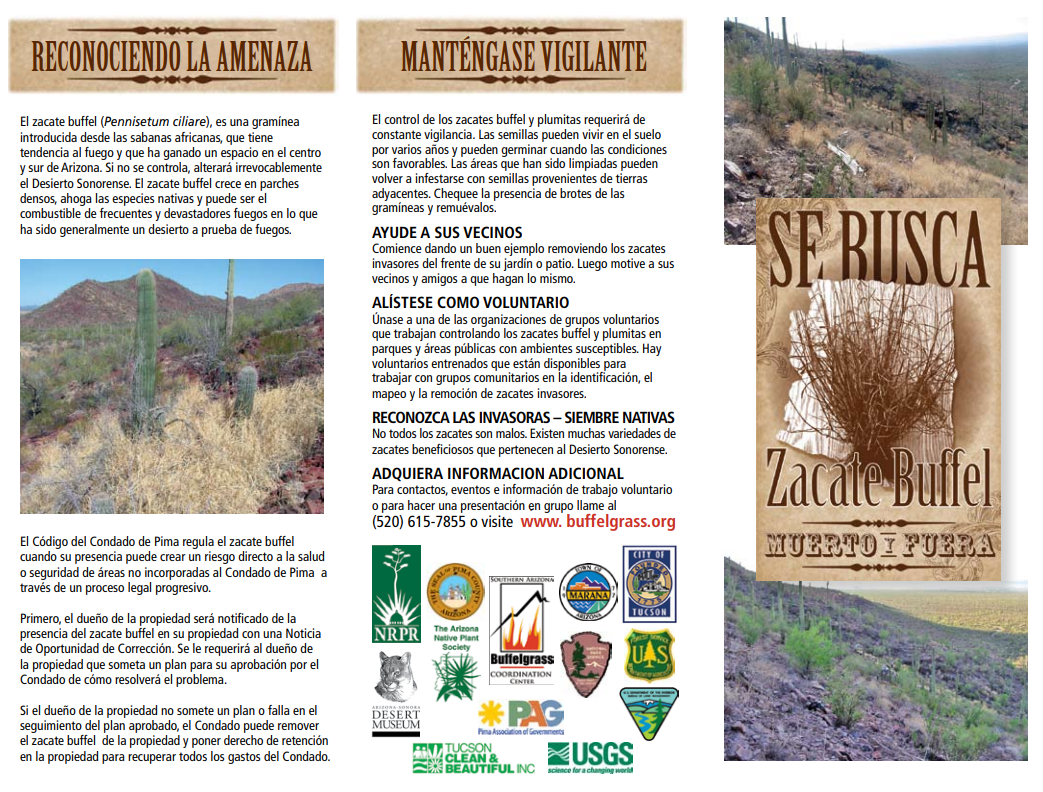 | Wanted: Buffelgrass, Dead and Gone (Spanish) | El zacate buffel se dispersa agresivamente a través de semillas que se acumulan en macollas densas, las cuales ahogan las plantas nativas. Estas macollas densas soportan fuegos muy calientes que matan los sahuaros y otras plantas características del Desierto Sonorense. |
 | The Long Journey from Buffelgrass Introduction | Buffelgrass (Pennisetum ciliare) has become the most notorious noxious weed in southern Arizona. |
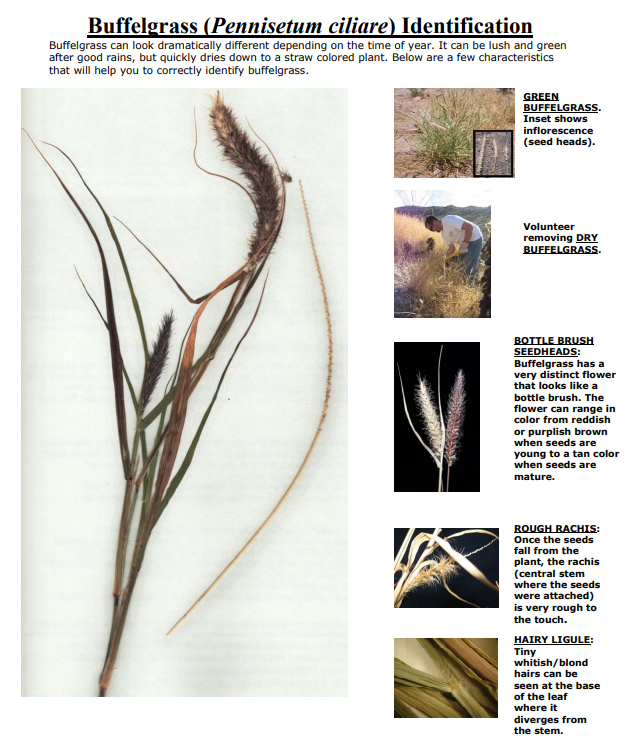 | Use of Herbicide to Manually Remove Buffelgrass | Buffelgrass can look dramatically different depending on the time of year. It can be lush and green after good rains, but quickly dries down to a straw colored plant. This resource will help you to correctly identify buffelgrass. |
 | Stinknet (Globe Chamomile) is a fast moving invasive | A pretty flower but an invasive weed in our midst. |
 | Stinknet Brochure | The weed has spread from several initial infestations in Northwest and North Phoenix into metropolitan Phoenix and is now spreading into Southern Arizona. |
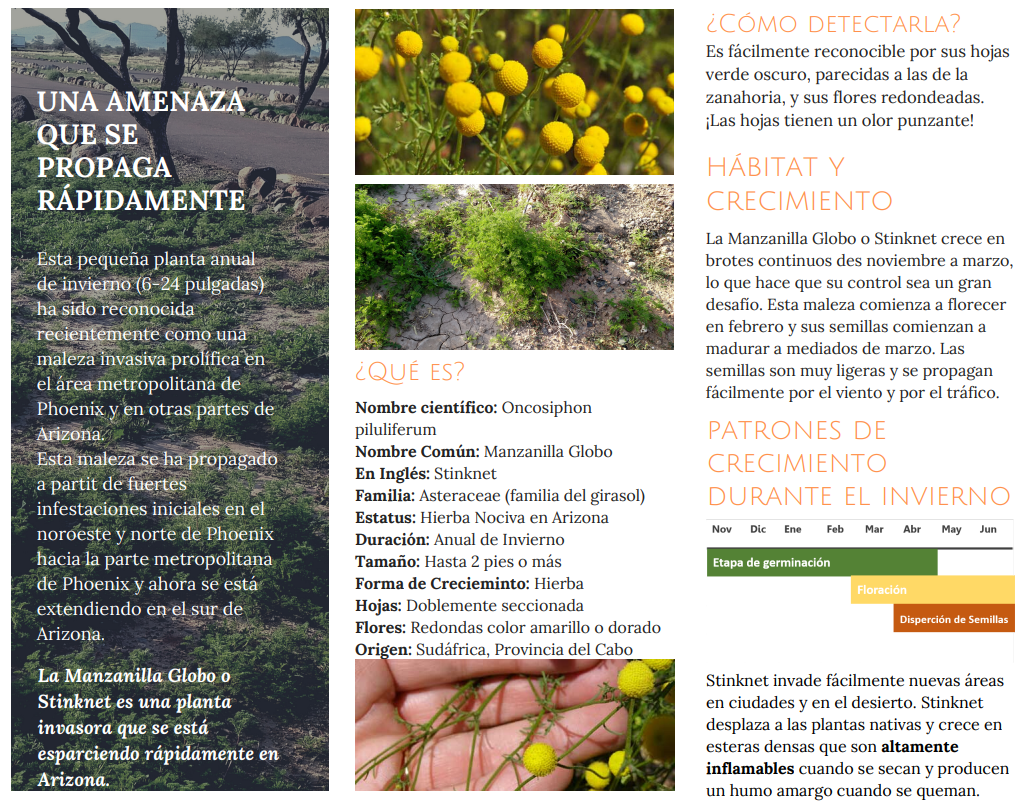 | Stinknet Brochure in Spanish | Esta maleza se ha propagado a partit de fuertes infestaciones iniciales en el noroeste y norte de Phoenix hacia la parte metropolitana de Phoenix y ahora se está extendiendo en el sur de Arizona. |
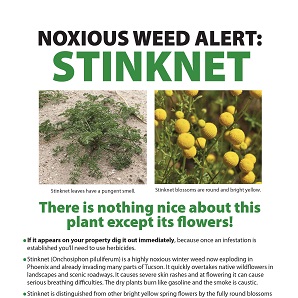 | Stinknet Poster | Small downloadable poster with information about Stinknet. |
 | Stinknet: Introduction to Eruptive Explosion | Stinknet (Oncosiphon pilulifer) was largely unknown to Arizonans in 2000. By 2020, it had invaded the Phoenix Metro Area across urban, suburban, and outlying natural areas alike. Rapidly spreading along roadsides, the stinknet infestation is now in full expansion around Tucson, Casa Grande, Buckeye, and Ajo. It is the fastest spreading invasive weed ever to have occurred in Arizona. This paper traces the brief journey from the first sightings of stinknet in Arizona to its detection in multiple locations in central Arizona, and its explosive growth in the years 2017–2020. |
 | Fountain Grass (Pennisetum setaceum) | Fountain Grass is a nonnative plant used as an ornamental landscape grass. Seeds easily spread and invade neighborhoods, roadsides, washes, and natural areas. |
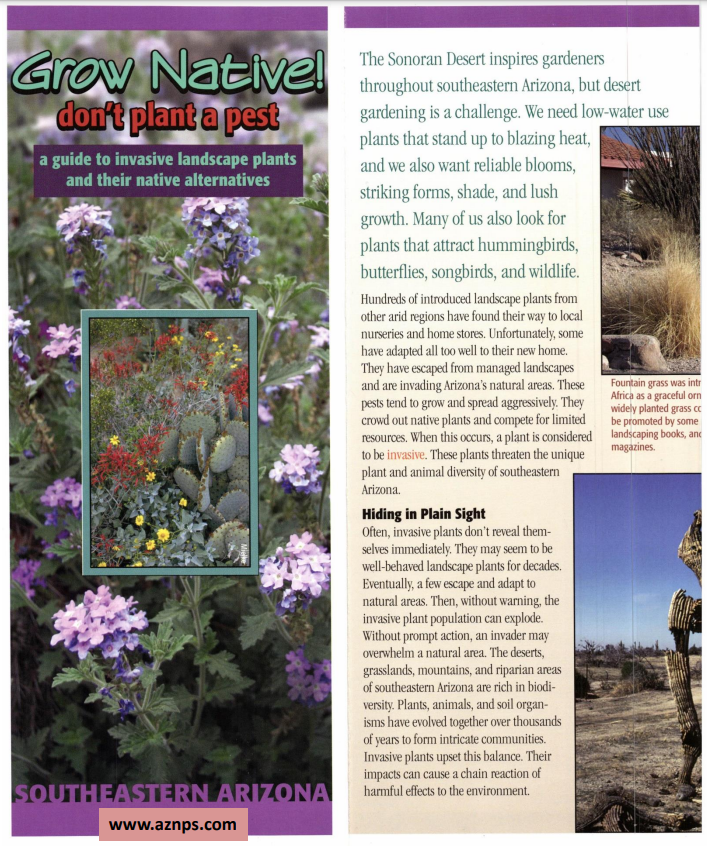 | Don’t Plant a Pest! | A guide to invasive landscape plants and their native alternatives. |
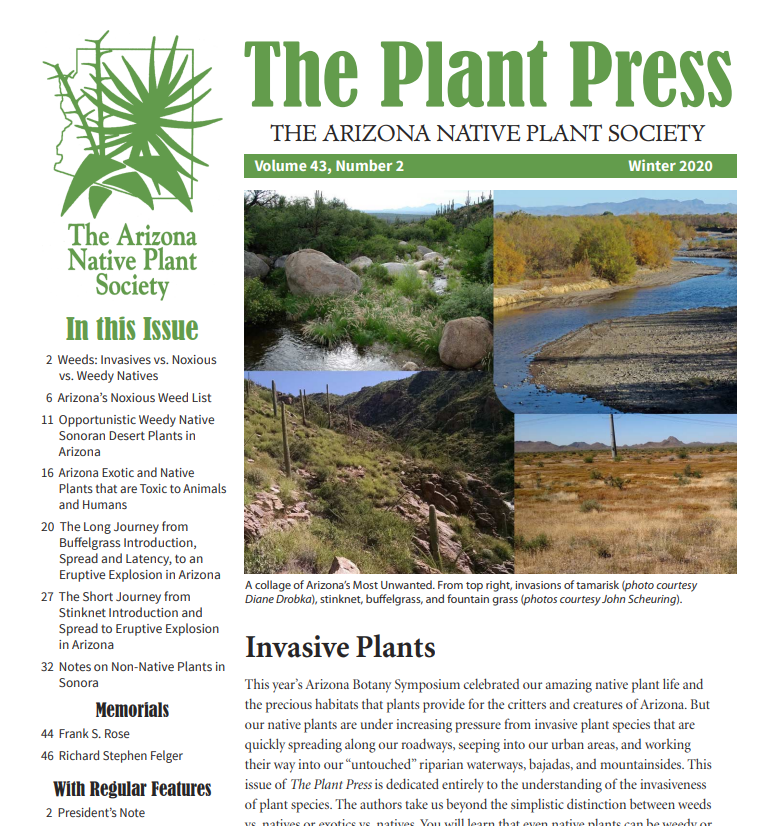 | Plant Press Arizona, Winter 2020, Invasive and Toxic Plants | A selected edition of The Plant Press that contains valuable information regarding invasive plant species. |
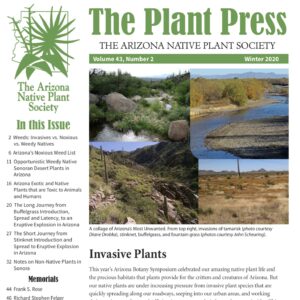 | Weeds: Invasives vs Noxious vs Weedy Natives | The 2020 Arizona Botany Symposium celebrated our amazing native plant life and the precious habitats that plants provide for the critters and creatures of Arizona. But our native plants are under increasing pressure from invasive plant species that are quickly spreading along our roadways, seeping into our urban areas, and working their way into our “untouched” riparian waterways, bajadas, and mountainsides. This issue of The Plant Press (Winter 2020) is dedicated entirely to the understanding of the invasiveness of plant species. |
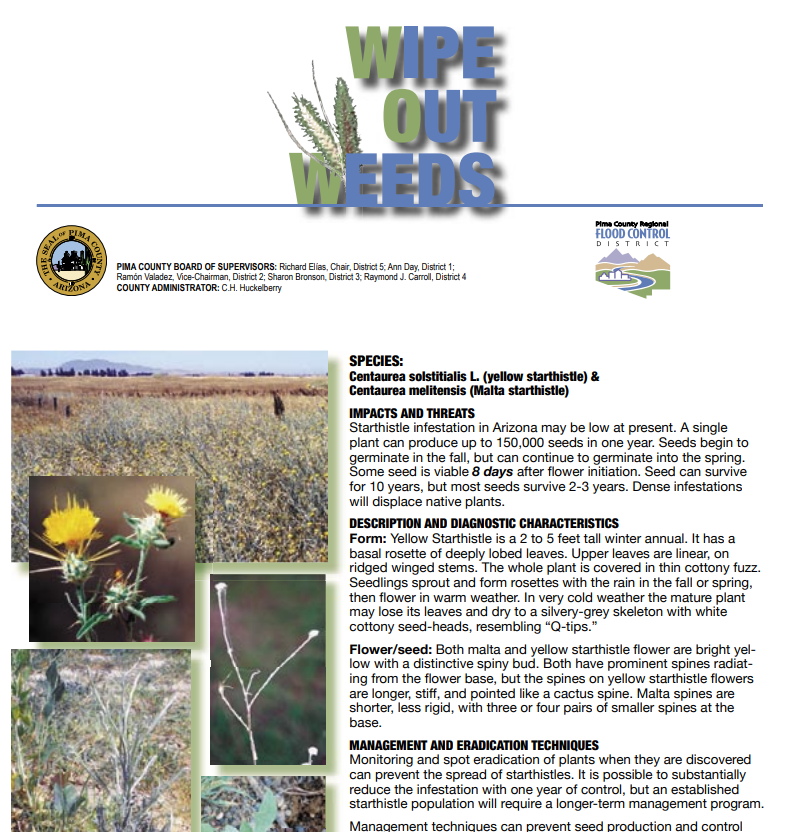 | Wipe Out Weeds from Pima County | A list of various types of weeds commonly found in Pima County with their accompanying eradication techniques. |
Additional Plant Publications
| What You’ll See | Article Title with Link | Brief Description |
 | A Keystone Desert Grass Reaches Arizona | Bouteloua diversispicula is a keystone species in large portions of the Plains of Sonora Subdivision in central Sonora, where it plays an important ecological role in binding fragile desert soils. |
 | Arizona Native Plant Recipes | Various recipes containing native southwestern plants. |
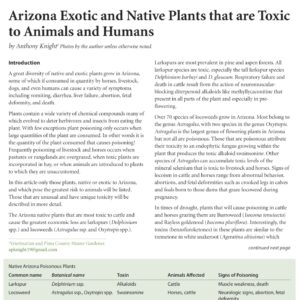 | Arizona Toxic Plants | In this article only those plants, native or exotic to Arizona, and which pose the greatest risk to animals will be listed. |
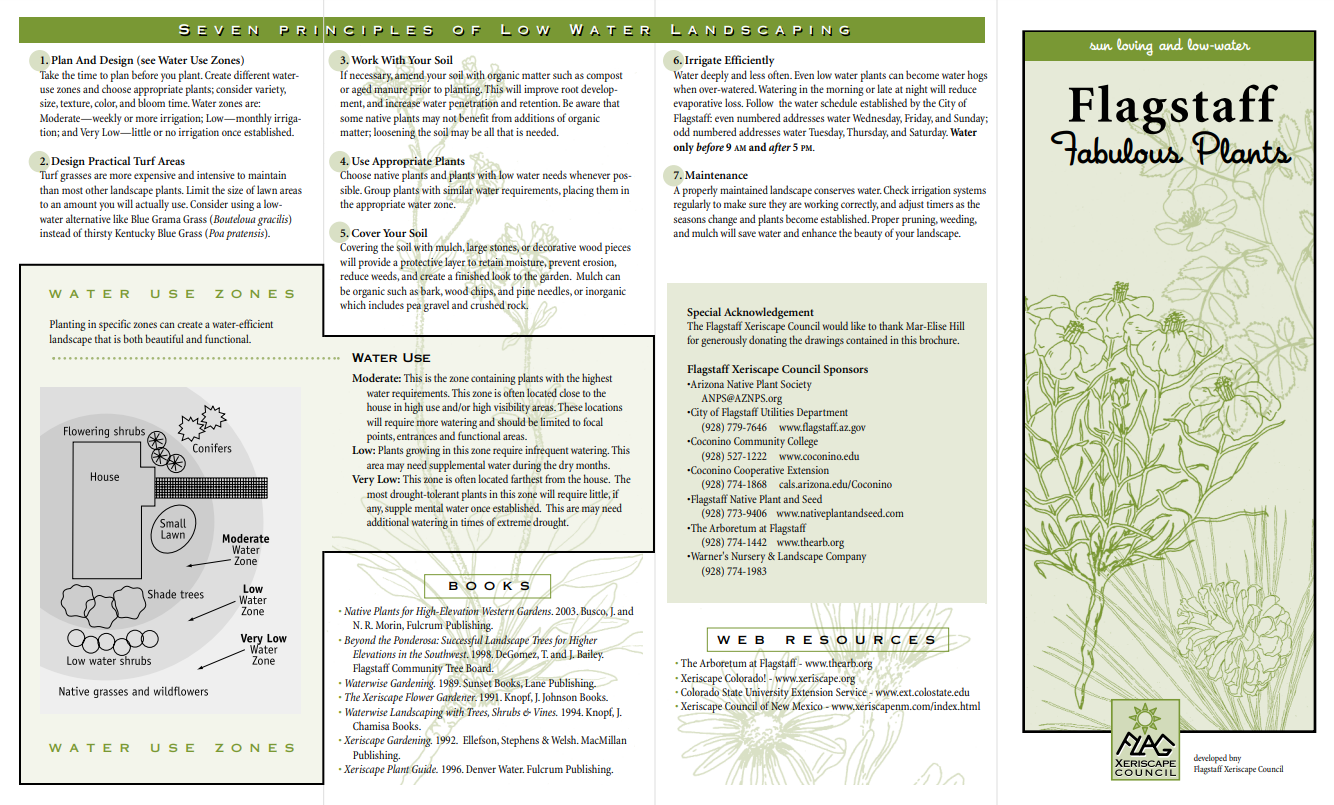 | Flagstaff: 50 Fabulous Plants | Flagstaff homeowners quickly learn how dry summers, cold temperatures, high altitude, and a short growing season create special gardening challenges. Selecting the right plants will help create beautiful and lasting landscapes that require less maintenance and water. |
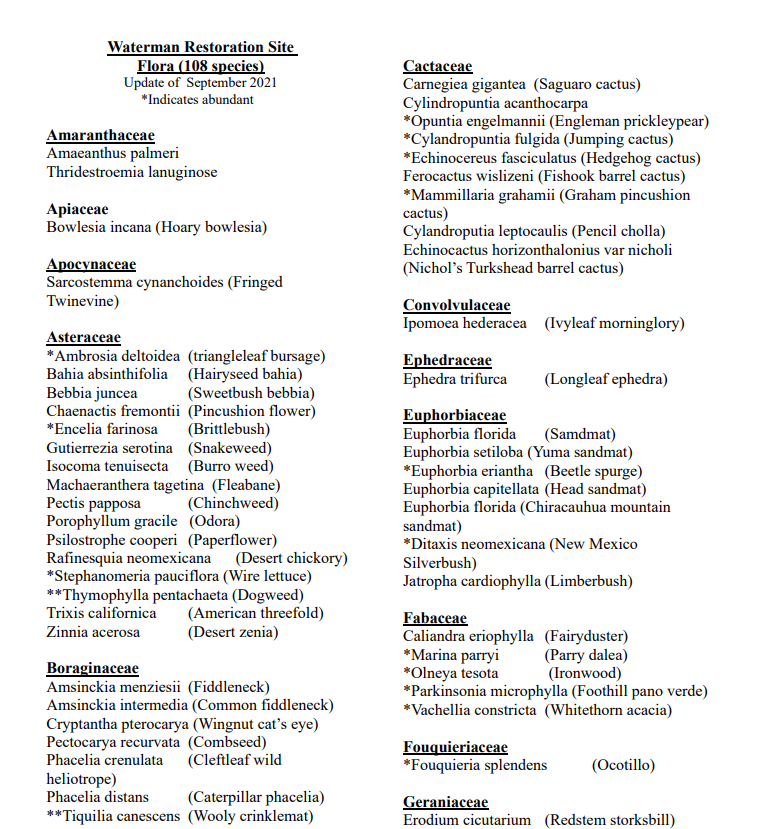 | Flora of the Waterman Mountains in the Ironwood Forest National Monument – September 2021 | A list of native plant species identified at the Waterman Restoration Site. |
 | Growing Wildflowers | Collecting and storing native wildflower seeds for your garden is fun easy and free. There are a few things to keep in mind before you go out gathering wildflower seeds… |
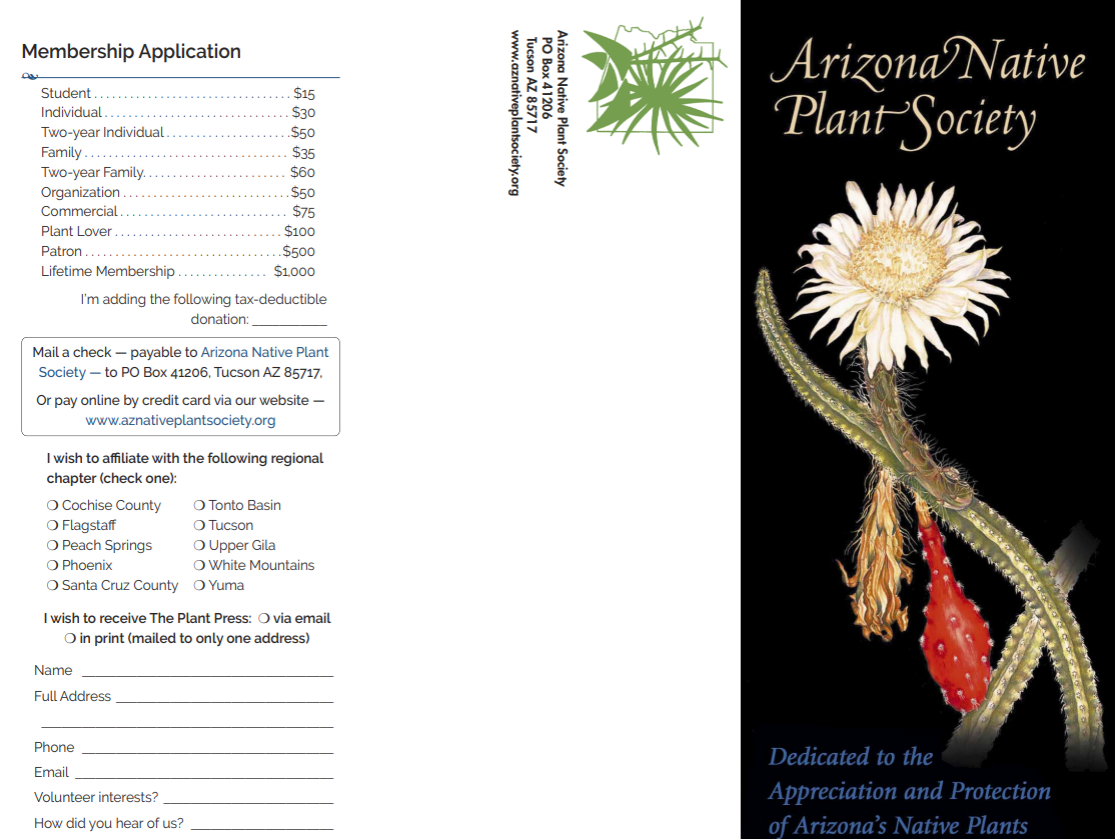 | Membership Brochure | Provides information on the mission of AZNPS, member activities and benefits, and membership information. |
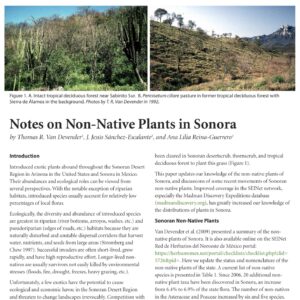 | Non-Native Plants in Sonora | With the notable exception of riparian habitats, introduced species usually account for relatively low percentages of local floras. |
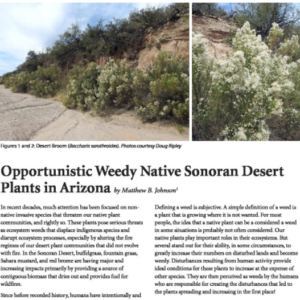 | Opportunistic Weedy Native Sonoran Desert Plants in Arizona | These plants pose serious threats as ecosystem weeds that displace indigenous species and disrupt ecosystem processes, especially by altering the fire regimes of our desert plant communities that did not evolve with fire. |
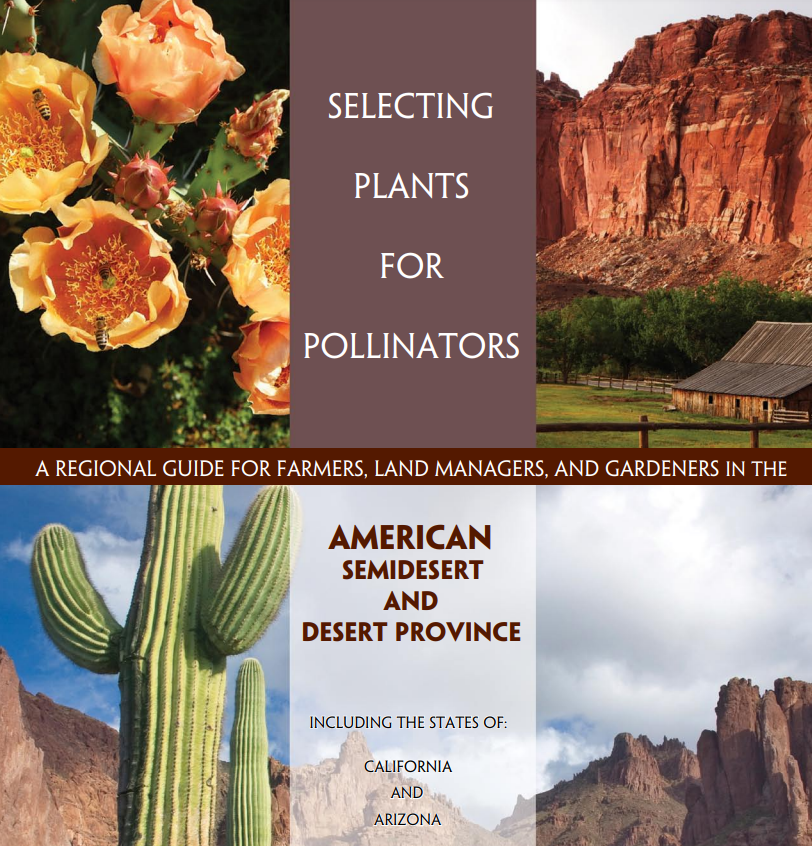 | Selecting Plants for Pollinators | A regional guide for farmers, land managers, and gardeners in the American semi-desert and desert province. Including the states of California and Arizona and parts of Nevada and Utah. |
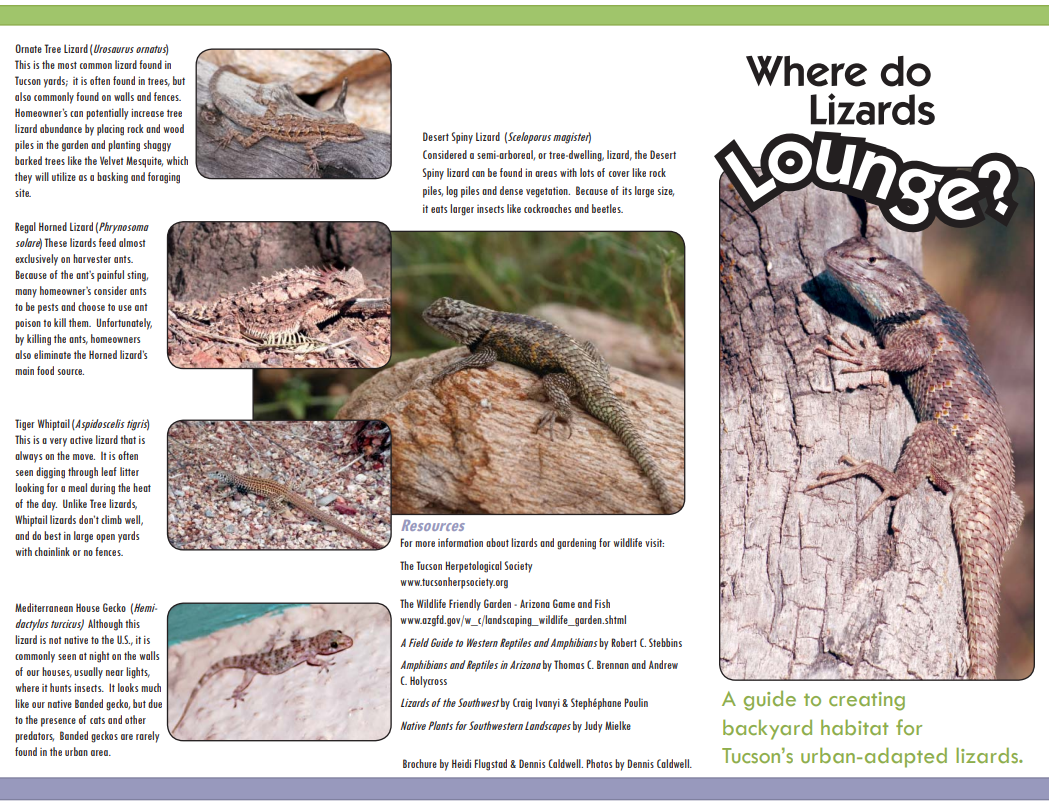 | Where Do Lizards Lounge? | A guide to creating backyard habitat for Tucson’s urban-adapted lizards. |
Links
| What You’ll See | Article Title with Link | Brief Description |
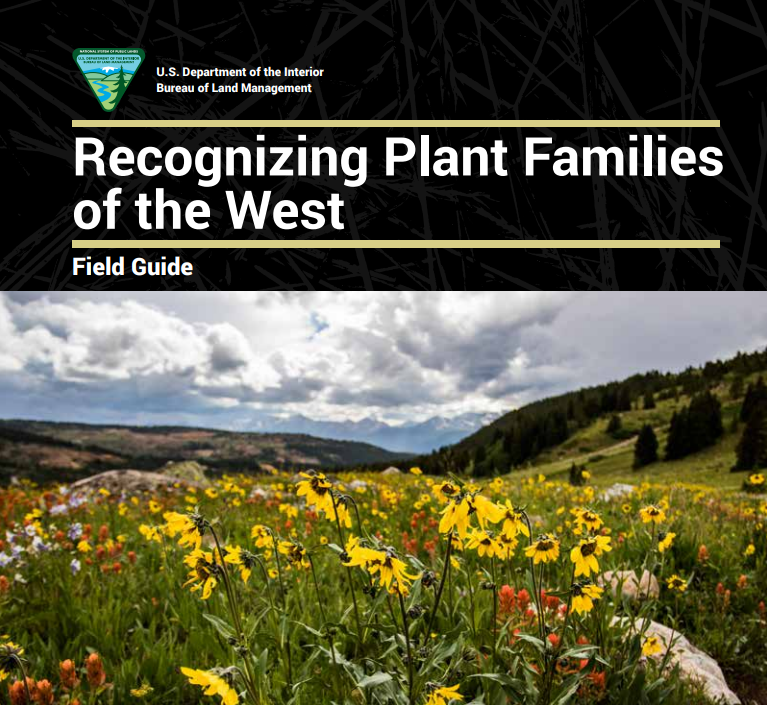 | Recognizing Plant Families of the West, a Field Guide. 218 pages, produced by the BLM. | The goal of this field guide is to enable readers to identify 54 flowering plant families. The focus is on illustrating the field recognition characters with photographs. Take the plunge – learn the characteristics of the plant families presented here – and in short order you will be automatically classifying the plants you encounter. |

